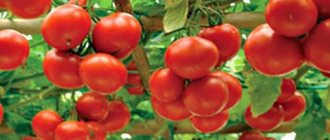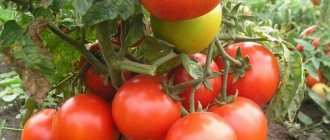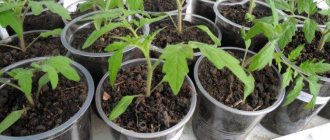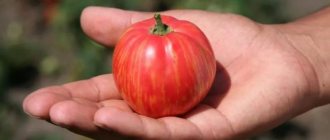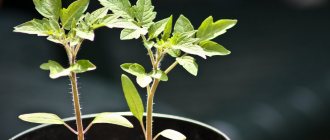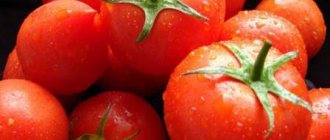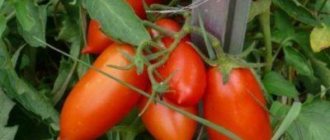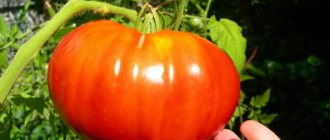Description of the Great Warrior tomato
Studying the description of a variety is one of the most important stages of preparation for the start of the summer season.
The Great Warrior tomato variety is an early ripening variety. From the moment the first shoots appear after sowing the seeds until the vegetables turn red, 110 to 115 days pass. Tomatoes of this variety are tall, interdeterminate plants. The height of the bush can reach from 1.5 to 2 meters. Based on this, it is worth noting that plants require a garter to a vertical support. It is also necessary to remove side shoots. To get maximum yield, the bush of this variety needs to be formed into 1 or 2 stems.
The main characteristic of a tomato is the ability to grow in unfavorable climatic conditions. Plants tolerate low temperatures well during the day and night. Suitable for cultivation in northern latitudes. They are practically not susceptible to the development of various diseases.
This variety does not have any specific growing characteristics. Great Warrior tomatoes can be grown in garden beds, greenhouses, and hotbeds. Tomatoes need regular feeding.
Description of the Ugazher tomato and recommendations for breeding the hybrid
The Uhazher tomato belongs to the group of compact-sized hybrids. Therefore, it can be grown in a city apartment using a loggia or balcony. The seeds of this variety are produced by the company Sedek. The hybrid, which has many fans, bears fruit well in greenhouses and open ground. The grown fruits are quite large in size. The skin of the Suitor has increased resistance to cracking. This allows you to store the crop for a long time or transport the berries over long distances.
- 1 Some information about the plant
- 2 How to grow the described tomato?
Some information about the plant
The characteristics and description of the variety are as follows:
- The first fruits appear 110-115 days after transplanting the seedlings onto permanent soil.
- The bush of the described variety rises in height by 0.8-1.0 m. An average number of leaves, colored in dark shades of green, grow on the stem.
- The first inflorescence appears above the 7th leaf, and subsequent similar elements develop through 2 leaves.
- The stalk has no articulations. There are no color spots on it.
- The fruits are cylindrical in shape with a smooth surface. The weight of the berries reaches 0.11-0.12 kg. Inside them there are 2 or 4 seed chambers. Ripe fruits are red in color, while unripe berries are green.
Many reviews are left by those farmers who grew this tomato variety. Gardeners indicate that Uhazher tomatoes need to eliminate stepsons, but at the same time they resist various diseases well. The Uhazher's yield is approaching 6 kg of fruit from 1 m² of bed.
Those people who planted the hybrid in their personal backyards claim that the tomato can withstand sudden changes in weather conditions. But it is better not to experiment with this property of the hybrid, otherwise you may lose the entire harvest.
The hybrid is successfully cultivated throughout Russia. It grows well in open ground in the southern regions of the country. Farmers in the middle zone use film greenhouses to grow this tomato. In the northern regions, it is recommended to plant Uhazher in greenhouses with good heating.
The hybrid is used for canning and pickling. Tomato paste, ketchup, juices, and sauces are made from it. You can eat Ujazher fresh or prepare salads.
How to grow the described tomato?
Even a novice gardener can grow a good harvest if he follows all the recommendations of experts. Any deviation from the rules will result in a loss of 30 to 50% of the crop.
To get strong shoots, the seeds are sown in the first ten days of March, placed in containers with special tomato soil to a depth of 15-20 mm. Then the crops are sprayed with warm water and the boxes are covered with film.
In order for the seedlings to germinate within a week, it is recommended to maintain a room temperature of +21...+25°C. After the sprouts sprout, the container with the tomato is transferred under special lamps, providing maximum illumination to the young plants. Seedlings need to be watered regularly. Fertilizing is carried out with organic mixtures, for example, peat and manure.
The sprouts are transplanted to permanent soil in mid-April. Before this, the bushes are hardened for 7-10 days. The soil must first be loosened and nitrogen fertilizers introduced into it. Uhazher is planted according to the 0.5x0.5 m pattern. The formation of a bush is carried out from 3-4 stems. Sometimes it is necessary to tie the stem to a support.
Subsequent fertilizing with potassium and phosphorus fertilizers is carried out after the development of the ovary, then when the fruit appears.
Watering is carried out as needed, when the soil under the bushes is completely dry. The procedure is carried out with warm water in the evening or early in the morning. There is no need to moisten the soil too much, otherwise the roots will begin to rot. It is recommended to promptly weed the beds to remove weeds and carry out loosening to ensure an influx of oxygen to the tomato root system.
To prevent the development of various diseases, it is recommended to treat the leaves and trunks of plants with medications that destroy fungi and various bacteria.
The threat of crop destruction by garden pests can be eliminated if preventive measures are taken against them, for example, treating the leaves on the bushes with a soap solution. If this does not help, then the extermination of aphids, Colorado potato beetles and other insects is carried out with chemical toxic substances, which can be purchased in specialized stores.
To destroy parasites entrenched on tomato roots and slugs, it is recommended to treat the soil under each plant with ash flour.
Characteristics of tomato fruits
What are the characteristics of the fruits of this variety?
Description:
- The fruits are very large, the weight of one vegetable can exceed 500 g;
- The fruits do not crack and can be stored for a long time after harvesting the entire crop;
- Ripe vegetables are very juicy, high in sugar, without any sour taste;
- From 4 to 6 tomatoes can be formed in one brush;
- Great Warrior tomatoes are pink, the shade of the skin and pulp is the same;
- There is strong ribbing and a green spot near the stalk;
- Long fruiting period, vegetables can be harvested until the end of August;
- Stable yield, from one adult bush you can harvest up to 18 kg of ripe vegetables;
- Universal use of vegetables in cooking. Ripe vegetables can be eaten fresh or added to salads. They also make delicious tomato juices, sauces and lecho. The only negative is that tomatoes cannot be rolled whole into jars because they are too large. But you can preserve chopped tomatoes.
- You can plant seedlings on any soil, even infertile.
See also
Description of the tomato variety Extreme, its characteristics and cultivationRead
What gardeners say about tomatoes
Those who grew the Sweet Girl hybrid leave only positive reviews about it. I like the simplicity of growing tomatoes. Many praise the variety for its high-quality and abundant fruiting. Sometimes it is not easy to collect tomatoes for harvesting, as they are quickly eaten by household members. Children are ready to feast on sweet clusters of red fruits all the time.
Using the fruits of the variety for canning, they note that much less sugar is used to prepare the marinade. The preparations turn out tasty and are eaten first. Sweet fruits are excellent for drying. They can be dried whole and used in winter for preparing main courses and salads.
Advantages and disadvantages
The Great Warrior tomato has a large number of advantages and virtually no significant disadvantages.
Description of the merits of the Great Warrior:
- Rich harvest throughout the fruiting period;
- Versatility of use for culinary purposes;
- The fruits do not crack and can be stored for a long time;
- The bushes tolerate unfavorable weather and are suitable for growing in open ground even in Siberia;
- Seedlings can be planted on infertile soils;
- Late blight and other diseases of nightshade crops are rarely affected.
Description of disadvantages:
- The plants are tall;
- It requires staking and removal of side shoots.
Landing
Planting tomatoes of the “Superbomb” variety is carried out in 2 stages: planting seeds for seedlings and planting seedlings (bushes) in the ground.
Growing seedlings
Sow prepared tomato seeds in March (2nd decade) or early April, 55-60 days before transplanting to a permanent place in a personal plot. As the seedlings grow, they gradually turn into strong bushes about 35 cm high with approximately 10 leaves and 2 clusters of flowers. It is advisable to pick seedlings at the stage when 1 or 2 true leaves appear on the bushes.
Landing in the ground
Ready “Superbomb” seedlings should be transplanted into open ground in May or early June. In regions with a warm climate, the variety can be planted in ordinary beds, but in regions with colder late summer and early autumn, tomatoes are still better off in greenhouses. This tomato variety loves neutral, organic-rich, well-drained soil mixtures, but is quite sensitive to boron and potassium deficiencies. Therefore, before planting, it is recommended to throw a small amount of fertilizer into all holes that is suitable for such purposes.
Superbomb tomatoes are unpretentious and do not require much care. The bushes like to be watered at the root, abundantly, but not very often. The only larger amount of moisture is required at the stage when the fruits are growing most intensively. If possible, you should avoid getting moisture on the leaves, fruits, and trunk, which can contribute to the onset of fungal infections of tomatoes. In addition, tomatoes do not like high air humidity. After planting and the first watering, the soil needs to be mulched. In this case, the most optimal irrigation option, allowing the bushes to develop a strong root system, is the organization of drip irrigation systems for the soil.
It is recommended to regularly feed “Superbomb” tomato bushes with complex fertilizers, including those containing the microelements boron and potassium. Another element of caring for tomato bushes is tying branches to supports, which is necessary to hold ripening tomatoes. Also, for bushes with a height of about 0.8 m and above, it is necessary to regularly carry out the pinching procedure, that is, remove excess branches. Moreover, in order to maximize productivity, the bush is formed into 2-3 stems.
“Superbombs” are resistant to most diseases common to tomato crops. The only significant drawback in this regard is the susceptibility of tomatoes to late blight and Alternaria, as well as some pests (wireworms, whiteflies, mole crickets, caterpillars). To reduce harm from late blight and alternaria, it is recommended to periodically use the chemical “Ordan”, intended for spraying bushes, but the last spraying must be carried out at least 20 days before harvest. To get rid of dangerous whiteflies, mole crickets, wireworms, and caterpillars, you can use the product “Confidor”, the chemical “Thunder” (as well as an infusion of hot pepper or a solution of vinegar), the drug “Bazudin”, the chemical “Strela”, respectively.
“Superbomb” tomatoes can be classified as mid-season tomato varieties. The period of complete ripening of vegetables is set at 105-115 days from the moment of full germination. It is advisable to complete harvesting before the cold snap, corresponding to a drop in ambient temperature to +8 0C. This is due not only to the cessation of tomato growth, but also to an increased risk of tomato diseases.
Features of cultivation, planting and care
We recommend sowing the seeds of this tomato variety for seedlings 60-65 days before the intended planting in the ground. Seedlings dive at the stage of two true leaves. When planting seedlings per 1 sq. Place 3-4 plants per meter of plot.
Further care for tomatoes consists of timely watering, fertilizing with complex mineral fertilizer, pinching and preventive measures to protect against diseases and pests.
How to tie up tomatoes quickly and easily on video
If you grew Great Warrior tomatoes, please write whether you liked them or not. What was the yield and taste of the fruit under your conditions? Will you grow them again? Briefly describe the advantages and disadvantages of this variety in your opinion. If possible, attach a photo of these tomatoes to your comment. Thank you!
Your reviews of the Great Warrior tomato and additions to the description will help many gardeners evaluate this variety more objectively and decide whether it is worth planting or not.
source
How not to make a mistake and choose the most productive variety of tomatoes? One of these varieties is the Great Warrior tomato. This tomato is unpretentious to grow and is suitable for cultivation in closed as well as open areas in the garden.
What advantages does the variety have?
The early ripening tomato Great Warrior differs from other early varieties in its large sweet fruits of rich crimson color with a glossy sheen. This variety produces large flat-round tomatoes weighing at least 200 grams. The seed pods are small and contain minimal seeds.
The pulp is dense, fleshy, the skin is thick. A ripe fruit has a green spot near the stalk and pronounced ribbing. Ready-to-eat tomatoes are resistant to cracking. They tolerate transportation well and can last up to 2 weeks. The photo shows the fruits of the Great Warrior variety.
Tomatoes of this variety are grown in open and closed ground. It is an indeterminate plant reaching a height of 2 meters. The bush requires support. It needs to be formed, leaving no more than 3 main branches in the southern areas, and 1-2 in the northern areas. The first harvest is harvested no later than 110 days after emergence.
Important: To obtain tomatoes that reach a weight of 500 g, 6 ovaries are left on the bush, the rest are removed, which allows the plant to devote all its energy to growing fruits.
Description and characteristics of the variety
Great Warrior is an indeterminate tomato with tall, strong shoots. The length of the bushes ranges from 1.8 to 2 m. 7-8 fruiting clusters are formed on the tomatoes, the number of tomatoes is 5-6.
The average weight of the fruit is in the range of 180-220 g. The tomatoes are round in shape and bright red in color. The ribbing is pronounced at the stalk and is faintly noticeable along the barrels.
The pulp is fleshy, juicy, sugary, but not watery. The taste combines notes of sweetness and sourness. There are few seed chambers and seeds.
The best preparations from small tomatoes
There are many recipes for canning sweet small fruits:
- Red tomatoes are marinated using allspice peas, black pepper, bay leaves, and garlic cloves. These ingredients are placed at the bottom of liter jars. Preparation of the marinade is usually: for 750 milliliters of water - one and a half tablespoons of salt, two - sugar, take nine percent vinegar in the amount of four teaspoons. You need to pour the tomatoes twice: first with boiling water, then with boiling marinade.
- To improve the taste, add a bunch of tarragon, basil, parsley, and an umbrella of dill to the jars.
- Tomatoes are good in their own juice. To prepare the juice, take the same number of fruits as the Sweet Girl variety. Dill, pepper, bay leaf, and garlic cloves are placed at the bottom of the jars. Then the containers are filled with small fruits. Pour boiling water over them twice, draining the water. The third time comes the turn of boiled tomato juice, to which a tablespoon of salt and two of sugar are added per liter.
- For drying, whole tomatoes are placed on a baking sheet, placed in a ventilated, hot room. As soon as the fruits are dry, they are placed in jars and filled with vegetable oil.
Usage
The variety is intended for fresh consumption and for processing. It is recommended to be used for slices and salads. The fruits are suitable for making sauces and pastes. According to reviews, the “great warrior” tomato is ideal for whole-fruit canning. During heat treatment, the skin does not crack.
The taste of tomatoes is balanced, sour-sweet, strong, tomato aroma. The first fruits are usually harvested in late June or early July. Fruiting lasts for a long time, until late autumn.
In some regions of the country, part of the crop is harvested unripe. With this harvesting method, the sugar content decreases and the fruits become more sour.
Useful properties of tomatoes
They contain a lot of vitamins - a well-known fact. Tomatoes contain lycopene, a very powerful antioxidant. Lycopene is absorbed much better if the tomatoes have been cooked; season fresh tomato salad with vegetable oil, then lycopene will be absorbed to the maximum. Tomatoes have a positive effect on the nervous system, as they contain serotonin, the “joy hormone” that will protect you from depression.
High iron content will protect the heart and blood vessels from diseases. Tomato skins and seeds improve intestinal motility. Those who are trying to lose weight should definitely have tomatoes in their diet. The love for tomatoes is well deserved, which has led to them becoming the most common and most grown vegetable in the world.
Abakan pink
Suitable for greenhouses, type of fruiting – extended. Fruiting begins 115 days after emergence. The tomatoes are large, up to 500 g, the flesh is pink. The shape of the tomato is very similar to the well-known variety Bull's Heart. The pulp has a pleasant taste, more suitable for salads. The bush grows up to 2 m.
Nobleman
Refers to mid-season varieties, 110 – 120 days are required for fruit to appear. The tomatoes are tasty, aromatic, weighing up to 350g. Use in cooking: salads. Plant height 55 – 60 cm.
a great warrior
Tall variety, requires garter. Fruiting begins 110 days from the first shoots. The shape of the tomatoes is flat-round, weighing up to 500 g. Due to the size of the fruit, it is difficult to use in canning, but they are ideal for salads. Productivity: 19 kg per 1 sq. m.
Sensei
Gives an early harvest. The plant is compact up to 1.5 m in a greenhouse, slightly smaller in open ground. The fruits weigh about 400 g, heart-shaped. Fruiting almost until frost. The technical maturity of the fruit is determined by its crimson color. The pulp is pleasant to the taste, sugary, low in seeds.
King of the Giants
Mid-season, very large-fruited. The weight of the tomatoes is 800 – 1000 g. When technically ripe, they are deep red, have a pleasant sweetish taste, and are very fleshy. Culinary use: salads.
A small plant that grows up to 80 cm in a greenhouse, breeders have experimentally determined that the yield reaches 9 kg per 1 sq. m. Tomatoes are large, fleshy, about 500 g.
Scarlet candles
Belongs to mid-season varieties, the shape of the fruit is oblong, cylindrical, cigar-shaped. The fruits weigh 100 - 120 g. They are not large, but there are a lot of them, the whole bush is strewn with tomatoes. Productivity 11, -12 kg per 1 sq. m. The dense skin prevents the tomatoes from cracking.
Chanterelle
About 110 cm high, tolerates temperature changes well, high-yielding variety, 9.1 kg per 1 sq.m. The fruits are small, their weight is 110 g. At technical ripeness, they are orange. Oblong shape. The skin does not crack during canning.
King of Siberia
According to gardeners, it is the best and most productive variety. The fruits weigh about 700 g, have a rich taste and density, do not crack, and are orange in color. The bush needs to be tied up, otherwise the branches will break off.
Golden domes
A very unusual tomato of Siberian selection. It differs from other varieties in both color and taste. At technical maturity, the fruits become yellow with green stripes. Very tasty. Up to 200 g. When cut, it is soft green in color. According to reviews from gardeners, they are poorly transported, you need to get used to the variety, since it is not clear how to determine technical maturity.
The variety has a bright orange color and can be compared to an orange. Tomato weight is 150 - 200 g, under favorable conditions up to 450 g. You can prepare sauces and salads. They are not suitable for canning, as the skin cracks and the tomato falls into pieces.
Demidov
Tomato weight 80 - 120 g, deep pink color when fully ripe, good taste, long shelf life. The plant is weakly branched, so it does not require pinching. Productivity is high, the variety is very resistant to diseases, tomatoes set even under unfavorable natural conditions.
Grandma's secret
A variety that has very large fruits, their weight is up to 1 kg, the shape of the tomato is round, slightly flattened. The pulp is dense and juicy. It makes very successful tomato juice, paste, and ketchup. Salads have a rich tomato taste. Very few seeds. It is difficult to collect them for the future harvest. The plant itself is strong, powerful, tall.
Bull forehead
The variety is extremely unpretentious and resistant to temperature changes. Productivity is high: 17 – 18 kg per 1 sq. m. Tomatoes are large with dense pulp. More suitable for preparing fresh salads. Their weight is up to 400g.
Goose egg
Varietal qualities
The “great warrior” tomato is a variety bred by Siberian breeders for greenhouses and open ground.
The bushes are indeterminate, up to two meters high. The plant is powerful, with well-developed foliage. To prevent the plant from breaking under its own weight, it needs to be provided with support - tied to a trellis. The first garter is carried out under the first flower brush. Next, garters are placed under each inflorescence. This method helps keep the fruits on the bush. Each cluster produces up to seven large fruits weighing about 300 grams each. The total load on the plant is up to two kilograms. In the “great warrior” tomato, the first fruits are larger than the subsequent ones.
To get an even harvest, part of the last ovaries is removed.
What agricultural technology is required for this variety?
Sowing seeds for seedlings is carried out at the end of March, 2 months before planting the plants in the garden. In areas where summer lasts throughout September, seeds of this variety can be planted in open ground on May 1. When the weather allows, they will begin to grow and quickly catch up with those plants that were grown in pots on the windowsill or in the greenhouse. The difference in fruiting is 2 weeks.
Before sowing in the ground, seeds should be treated with Fitosporin and a growth stimulant, using the dosages specified by the manufacturer. This will destroy fungal diseases and give the seeds additional growth energy.
Sow the treated seeds in heated peat or soil prepared in the fall. Home soil needs to be disinfected by spilling it with a saturated solution of potassium permanganate, made at the rate of 1.5 g per 5 liters of water. You can warm the soil on the stove until smoke appears or spill the soil with Fitosporin, having previously read the recommendations class=”aligncenter” width=”500″ height=”333″[/img]
To make the seeds germinate faster, the containers are covered with cling film or covered with glass. The boxes are placed in a warm place where the temperature reaches more than 23C. When the first shoots appear, the containers are transferred to a south or west window and the film is removed. Seedlings need regular watering. After the first 2 leaves appear, the plants are fed with nitrogen, making a nutrient solution at the rate of 1 hour. l. urea per 5 l. water.
To get an early harvest, plants need to be picked and hardened off, placing the plants in the sun when daytime temperatures reach 18C. Before planting in the garden, the tomatoes are left to spend the night outside, covered with covering material.
Seedlings are planted in the ground after the threat of frost has disappeared, choosing a place open to sunlight. There are 3 bushes per 1m2. Pour 1 cup of stove ash, a handful of compost into each hole and pour in 2 liters of water. In infertile soil you can add 1 tbsp. l. granular complex fertilizer intended for tomatoes. The seedlings are buried deeply, leaving the top with 2-3 leaves on the surface. This planting increases the number of roots on the stem and improves the nutrition of the stem.
10 days after planting in the ground, tomatoes of this variety begin to be fed with liquid solutions containing microelements and nitrogen. This can be an infusion of mullein, green herbs, or a fermented solution of sugar and yeast. You can use specially formulated concentrated liquid fertilizers for industrially produced tomatoes. There should be no more than 3 feedings in total. The last application of a nutrient solution containing phosphorus is carried out after the ovary appears.
Attention: Plants that have dark green leaves, thick branches and form a large number of shoots do not need feeding. Fattening tomatoes of this variety will not bear fruit.
Plants can bloom before planting in the ground, when 8-9 true leaves are formed on the stem. The first flower cluster appears under the eighth leaf. It needs to be plucked off, because after transplanting into open ground the ovary will develop on it, significantly slowing down the growth of the rest of the plant.
The trunks are actively growing, and at the end of June they begin to bloom profusely and form an ovary. Tomatoes stop watering when the fruits begin to fill. For quick ripening, leaves are removed from the branches, leaving 2-3 leaves for nutrition, which allows the tomatoes to ripen faster.

